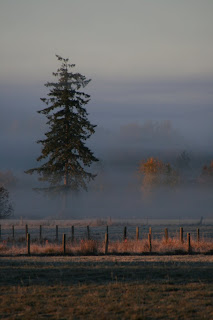 Some Big Leaf Maples were on solid display right here in Downtown Winlock.
Some Big Leaf Maples were on solid display right here in Downtown Winlock. That is the recipe for the kind of colors that we saw in October and are now watching as the leaves fall to the ground in the breezes and rain of the first fall storms.
The big star this year is clearly the Big Leaf Maple. The stretch of flawless fall weather occurred perfectly as the graceful trees began to shut down for the dark, winter season ahead. Granted, Big Leak Maple usually has a handsome color show, but this year it was particularly brilliant!
 This is a relatively dull scene on the North Fork Toutle River.
This is a relatively dull scene on the North Fork Toutle River.The leaves of deciduous trees change colors due to a number of environmental factors. During the summer months, the leaf is green because the tree is manufacturing color chlorophyll through the process of photosynthesis. When the daylight wanes, and days become subtly shorter, photosynthesis begins to shut down. The cells at the confluence of the leaf start to divide and block the fluid and moisture from the roots of the tree. Once the food supply is cut off, the underlying tones of yellow and orange appear. This begins to reveal the natural pigments of the leaf and to spectators like us, we view this as the “fall color” period.
Chemicals often determine the colors a tree will display. Many of our local trees simply turn brown due to high percentage of tannins in the leaves. Carotenoids are one of the main chemicals in the leaves of the Big Leaf Maple and the Vine Maple. This year however, a more dominant Xanthophyll, an oxidized derivative of carotene, helped our Big Leaf Maples as well as a variety of other trees show brilliant gold color instead of the usual brownish-orange.
 This Vine Maple just east of Toledo is showing its colors complete with the carotenoid chemicals that give the reds and oranges. These are the same chemicals that you would find in carrots.
This Vine Maple just east of Toledo is showing its colors complete with the carotenoid chemicals that give the reds and oranges. These are the same chemicals that you would find in carrots.One also should be asking why the Vine Maple here in Western Washington is not nearly as vibrant as its cousins in the mountains to the east. The answer is also weather. In the lower drainages of the Cowlitz, we don’t see nearly as much sunshine as most locations east of say, Morton. This is the same reason that makes New England famous for its fall color displays and Europe, which is covered with deciduous forests has a less than dynamic show. New England typically offers clear, cool weather in October while Europe has a persistent cloud cover during the fall months.
 The Cottonwood, just to the right of the big Douglas Fir has an easier ability to show Xanthophyll, the chemical that allows us to see more of the yellow and gold pigments after the tree stops producing chlorophyll.
The Cottonwood, just to the right of the big Douglas Fir has an easier ability to show Xanthophyll, the chemical that allows us to see more of the yellow and gold pigments after the tree stops producing chlorophyll.Regardless, how much we enjoyed our fall colors this year, we should always be asking what are the reasons for the beauty.





2 comments:
I miss the NW fall reds of the maples. Yet really enjoyed the golden aspens at Grand Canyon.
Did I read that right that you are back in the northwest?
Post a Comment